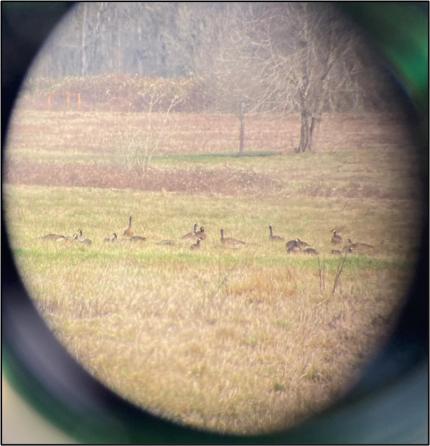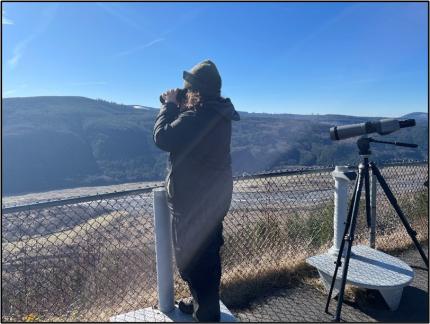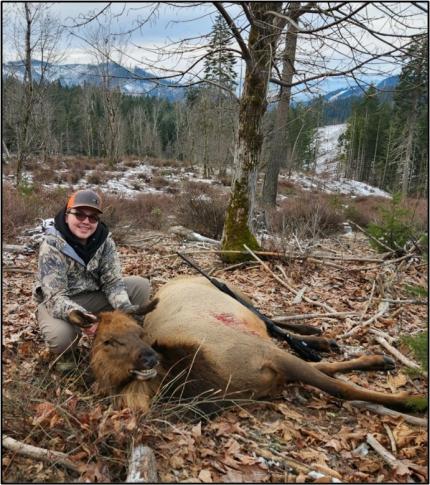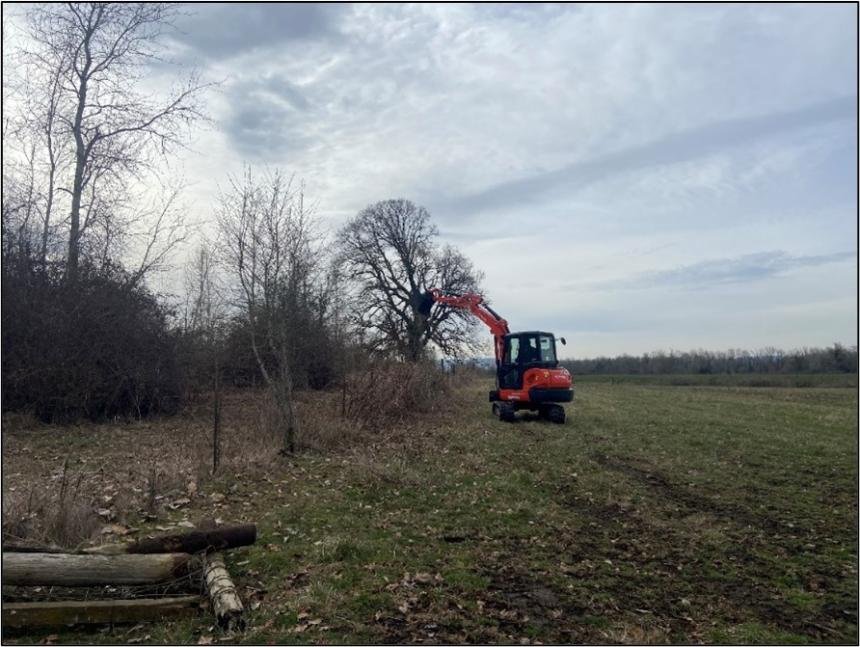Managing Wildlife Populations
Bat Hibernacula Surveys: Biologist Wickhem assisted Technician Leipold with bat hibernacula surveys in the Gifford Pinchot National Forest for two days this month. US Forest Service Technician Motiff and Volunteer Petrie also assisted in the effort. Together, the teams skied and snowshoed several miles and surveyed five caves where they counted and identified species of bats roosting in each cave. Two other caves were located but not surveyed because of access issues. When bats from the genus myotis were found and within reach, the bats were directly swabbed to test for the fungus that causes white-nose syndrome. These surveys are part of a larger effort to survey a portion of over 600 caves within the Gifford Pinchot National Forest to see which support hibernating bats, especially Townsend’s big-eared bats which are a Washington Species of Greatest Conservation Need (SCGN) and a Priority Species under WDFW’s Priority Habitats and Species Program. In Biologist Wickhem’s two days on the survey, she recorded 157 Townsend’s big-eared bats, one myotis and got to explore some amazing caves.




Dusky Canada Goose Surveys: Biologist Stephens and Holman continue to conduct dusky Canada goose surveys in Cowlitz and Wahkiakum Counties. The purpose of the surveys is to count dusky geese observed and read alphanumeric codes on any red collared geese. Wildlife managers survey the geese multiple times across their primary wintering grounds and use the data to generate survival estimates. The dusky geese are collared on their breeding grounds in Alaska every other year. Multiple species of Canada geese were located during the survey as well as Trumpeter and Tundra swans. Additionally, many wildlife species are incidentally encountered while conducting the goose surveys, especially in the relatively intact habitats of Wahkiakum County. These species included elk, Columbian white-tailed deer, black-tailed deer, many duck species, egrets and herons, bald eagles, and three species of marine mammals just to name a few.
Biologist Wickhem also continued dusky Canada goose surveys in Clark County, primarily on the Shillapoo Wildlife Area and around the Vancouver Lake Bottoms. On this survey, Wickhem recorded 161 dusky Canada geese including one with a red collar. Snow geese are still flocking in the thousands at Shillapoo, and there are still many ducks utilizing the wildlife area. Other species observed included northern harriers, red-tailed hawks, herons, egrets, sandhill cranes, and a juvenile bald eagle surrounded by white feathers feasting on a bird carcass.






Klickitat Mule Deer Study: Wildlife Conflict Specialist Jacobsen and Volunteer Lieberg worked to put out a satellite GPS collar on a female mule deer in central Klickitat County. This collar is one of a larger dataset of satellite collars, roughly 80, tracking female mule deer over multiple years as part of a federally funded mule deer migration project in Game Management Units (GMU) 388 and 382.

Treatment Turtle Transfer: Biologist Bergh picked up some of the northwestern pond turtles that had undergone treatment for shell disease at the Oregon Zoo and brought them to Cedar Creek Correctional Center near Olympia for their recovery. The turtles will be taken care of by three inmate technicians through the rest of the winter and released back into the wild this spring. This program is run by the Sustainability in Prisons Project out of The Evergreen State College and we are very grateful to the program and the technicians for their care of the turtles while they recover.
Mudflow Unit of the Mount Saint Helens Wildlife Area Elk Survey: Biologist Stephens and Customer Service Specialist Splitgerber conducted a survey of elk wintering on the mudflow in early February. They saw a total of 54 elk, which were classified as 30 bulls, 19 cows, and five calves. This survey is conducted twice a month between December and March.



Providing Recreation Opportunities
Abandoned Boat Removal: Private Lands Biologist Ferris was assisted by Private Lands Biologist Harris to retrieve an abandon boat dumped on an Access Program site in Wahkiakum County. Law enforcement investigation could not find a current registered owner. The boat had to be dragged several hundred feet to pavement where it could be placed on a flatbed trailer for removal. The Private Lands Access Program will fund the cost of this removal as a benefit of program enrollment.

Providing Conflict Prevention and Education
Eagle Complaint: A concerned livestock producer contacted Wildlife Conflict Specialist Jacobsen to discuss options for eagle deterrents around his calving operations. The producer has had issues in the past with bald and golden eagles harassing, injuring, and killing newborn calves. Jacobsen suggested multiple different deterrent options to the livestock producer. Federal protections afforded to eagles substantially reduces the available options for livestock producers in these situations.
Elk Damage Hunt: Wildlife Conflict Specialist Jacobsen deployed a youth hunter from the Region 5 Elk Damage Pool to a property in GMU 574 that was incurring damage from elk. The elk were damaging a newly planted hay seeding. Due to the unseasonably low (or nonexistent) snowpack in the area, the fields were more susceptible to damage than normal at this time of year. The youth hunter was able to successfully harvest an elk with symptoms of hoof disease on the first day of his hunt. Hopefully this hazing activity will keep the rest of the elk at bay and out of the fields.

Elk Damage to Wheat: Wildlife Conflict Specialist Jacobsen met with a Klickitat County landowner in GMU 382 regarding elk damage to his winter wheat. The hoof compaction damage to the wheat from over 50 head of elk was substantial, and the grazing damage was moderate. Jacobsen deployed a youth hunter to the property, who successfully harvested a cow elk on the first morning of his hunt. Jacobsen will continue to work with the landowner to deploy damage pool hunters to the property. Jacobsen will also work with the landowner to utilize a drone in their upcoming elk hazing efforts. The elk have become accustomed to cracker shells, so novel techniques are necessary in this situation.






Conserving Natural Landscapes
Out with the Old: Over several days, Assistant Manager Breitenstein, Assistant Manager Risley, and Technician Fox worked on removing old fencing at Shillapoo Wildlife Area. The existing fence is over 25 years old and has seen a lot of use and abuse over the seasons. The primary purpose of this fence is to contain the cattle that graze the pasture during certain parts of the year and prevent the cattle from gaining access to oak trees that were some of the first trees planted at Shillapoo for habitat reclamation and enhancement. Over the course of the next several weeks, new fencing will be put up, free of holes and rotten posts.

At the End of the Rainbow. Wildlife Area Manager Hauswald and Assistant Manager Risley surveyed for waterfowl at Shillapoo. These surveys are conducted twice weekly during the winter migration season to monitor habitat use by ducks, geese, swans, and sandhill cranes at the wildlife area. On this otherwise dreary day, a brightly colored rainbow made for some excellent photo opportunities.


Looking for Signs of Life and Tracks: Wildlife Area Manager Hauswald and Assistant Manager Risley ventured up to the Mudflow Unit of the Mount St. Helens Wildlife Area to monitor survival rates of willow, wild strawberry, and big leafed lupine that were planted during spring 2022 for streambank stabilization along the Toutle River. Unfortunately, high water events over the past two months resulted in significant bank loss and much of the plantings were washed down river.
Fresh snow fall provided an opportunity to look for large predator tracks. Several coyote tracks were observed as well as a few bobcat tracks, but no large predator tracks were found. The Mudflow Unit is currently closed to the public and will remain so until May 1. This closure is to provide refuge and protection for the elk that over winter on the Mudflow. Wildlife area staff members do not visit the unit regularly during the closure, but when visiting the unit is necessary great efforts are made to avoid the elk so as not to cause stress to the animals.


Providing Recreation Opportunities
Feline Hybrid: Wildlife Conflict Specialist Jacobsen responded to a media request regarding the mythical “Klickitat ape cat” that has been hotly debated by locals in the watering holes of Klickitat County. Jacobsen provided information on melanism in wildlife as well as on the biology of large cats of the world. Enough said on this nonsense.